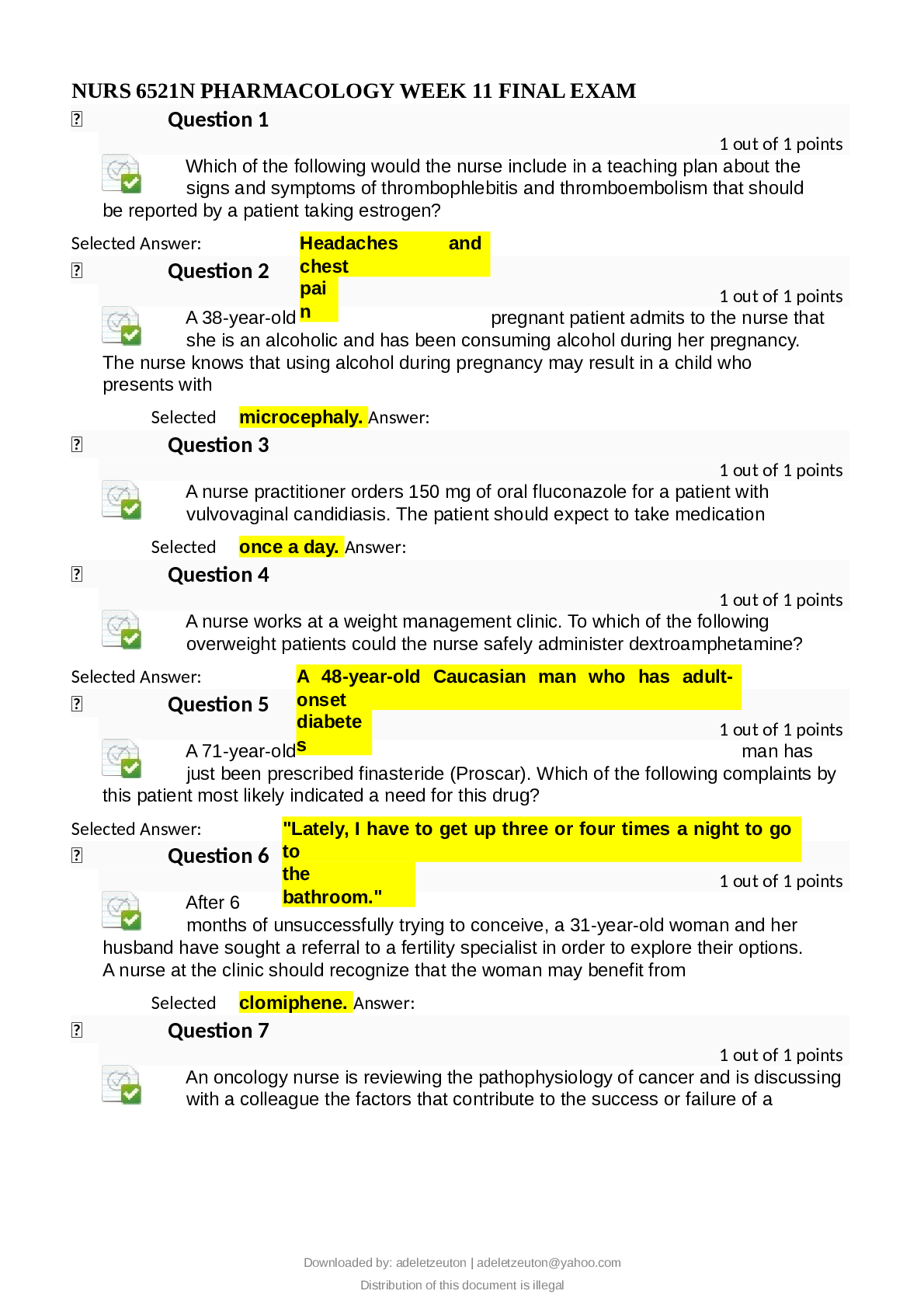NUR 634 Midterm Examination Answers
Document Content and Description Below
Is the following information subjective or objective? Mr. M. has a respiratory rate of 32 and a pulse rate of 120. 1. A) Subjective 2. B) Objective Which is the proper sequence of examination for ... the abdomen? 1. A) Auscultation, inspection, palpation, percussion 2. B) Inspection, percussion, palpation, auscultation 3. C) Inspection, auscultation, percussion, palpation 4. D) Auscultation, percussion, inspection, palpation Mrs. R. is a 92-year-old retired teacher who comes to your clinic accompanied by her daughter. You ask Mrs. R. why she came to your clinic today. She looks at her daughter and doesn’t say anything in response to your question. This is an example of which type of challenging patient? 1. A) Talkative patient 2. B) Angry patient 3. C) Silent patient 4. D) Hearing-impaired patient Which of the following is a clinical identifier of metabolic syndrome? 1. A) Waist circumference of 38 inches for a male 2. B) Waist circumference of 34 inches for a female 3. C) BP of 134/88 for a male 4. D) BP of 128/84 for a female Bill, a 55-year-old man, presents with pain in his epigastrium which lasts for 30 minutes or more at a time and has started recently. Which of the following should be considered? 1. A) Peptic ulcer 2. B) Pancreatitis 3. C) Myocardial ischemia 4. D) All of the above A 75-year-old retired teacher presents to your clinic, complaining of severe, unrelenting anterior chest pain radiating to her back. She describes it as if someone is “ripping out her heart.” It began less than an hour ago. She states she is feeling very nauseated and may pass out. She denies any trauma or recent illnesses. She states she has never had pain like this before. Nothing seems to make the pain better or worse. Her medical history consists of difficult-to-control hypertension and coronary artery disease requiring two stents in the past. She is a widow. She denies any alcohol, tobacco, or illegal drug use. Her mother died of a stroke and her father died of a heart attack. She has one younger brother who has had bypass surgery. On examination you see an elderly female in a great deal of distress. She is lying on the table, curled up, holding her left and right arms against her chest and is restless, trying to find a comfortable position. Her blood pressure is 180/110 in the right arm and 130/60 in the left arm, and her pulse is 120. Her right carotid pulse is bounding but the left carotid pulse is weak. She is afebrile but her respirations are 24 times a minute. On auscultation her lungs are clear and her cardiac examination is unremarkable. You call EMS and have her taken to the hospital’s ER for further evaluation. What disorder of the chest best describes her symptoms? 1. A) Angina pectoris 2. B) Pericarditis 3. C) Dissecting aortic aneurysm 4. D) Pleural pain A patient is assigned a visual acuity of 20/100 in her left eye. Which of the following is true? 1. A) She obtains a 20% correct score at 100 feet. 2. B) She can accurately name 20% of the letters at 20 feet. 3. C) She can see at 20 feet what a normal person could see at100 feet. 4. D) She can see at 100 feet what a normal person could see at20 feet. A 46-year-old former salesman pre [Show More]
Last updated: 2 years ago
Preview 1 out of 19 pages

Buy this document to get the full access instantly
Instant Download Access after purchase
Buy NowInstant download
We Accept:

Reviews( 0 )
$8.50
Can't find what you want? Try our AI powered Search
Document information
Connected school, study & course
About the document
Uploaded On
Aug 19, 2021
Number of pages
19
Written in
Additional information
This document has been written for:
Uploaded
Aug 19, 2021
Downloads
0
Views
69














